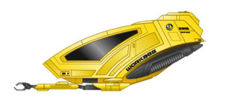Work Bee
From FEInfobase
| Work Bee | |

| |
| Class Information | |
| Category |
General Utility Craft |
| Dimensions | |
| Length |
4 meters |
| Height: |
1.67 meters |
| Engines | |
| Maximum speed |
Sub-impulse |
| Defensive Systems | |
| Phasers |
Phaser drill |
| Hull |
Carbon tetride laminated monotanium |
| Tractor beams |
Yes |
| Personnel | |
| Officers |
1 |
| [Source] | |
The Work Bee is a single-occupant vehicle with seating for the pilot only. Generally, the pilot must be spacesuited, especially if the pilot is planning extravehicular activity. The front of the Work Bee features several large windows. The craft also has a large headlight at its extreme forward end for illuminating a work area.
One of the most useful and long lasting designs in Starfleet history, the work bee was first fielded in the late 2260's in order to replace several previous craft of similar type. The major feature of the work bee is the highly modular nature of the design. The initial requirement called for virtually every system on board to be designed as a modular unit which could be disconnected, removed and replaced with great ease. This made the initial work bee design somewhat more complex and difficult to produce, but Starfleet was betting that it would prove its worth in the long run - and so it has proved. The work bee is simplicity itself to maintain; minor parts can be swapped out literally in seconds, while even major systems such as the micro-fusion power core can be replaced in under ten minutes, and even the hull itself can be broken up into four sections. This has given these bees one of the highest serviceability ratings in Starfleet history, with an average availability of 99.97%.
The modular approach has also made the work bee extremely easy to upgrade - all updated systems have been designed to fit the same physical requirements, so it is literally a matter of pulling an old component out and putting the improved one in place. No component swap requires more than three persons, and typically the total maintenance work required by the bees is so low that a three person crew can perform all routine maintenance on a group of fifteen bees.
The upgrade program for the work bees has been generally limited to gradual improvements rather than large leaps. Over their hundred year history virtually every part of the bees have been replaced many times over. The original design had a duotronic flight computer, an electro-optical passive scanner, and a hull constructed of carbon fibre plated with foamed aluminium alloys - a very old material which nevertheless met the strength and and density requirements. Today the bees exist in many variations according to how modern their equipment fit is; a typical work bee of the 2300's will have a small isolinear flight computer, a short range navigational laser radar, and a shell comprised of monotanium laminated with carbon tetride. The life support systems have been replaced several times as older systems reach the end of their operational life, or as newer safety standards come into force. Some have compared this rolling refit program to the proverbial thirty year old axe which has had four new heads and six new handles!
The work bee can carry out a multitude of tasks; there are two manipulator waldoes which can be tipped with a wide variety of tools for all kinds of construction and maintenance work on Starships and space stations. At the rear of the hull are standardized grapple points which can be used to attach various configurations of cargo containers, or alternately can be fitted with a tractor beam unit which can be used to tow small craft such as shuttles - a task the work bee would normally undertake only in emergencies. Some thought was given to designing drop tanks with extra fuel and life support supplies to extend the range of the bee several-fold, but although this was perfectly feasible there was never any real need for such an improvement and it was abandoned before serious development work was authorized.
Some thought was given to replacing the work bee with a totally new design. However, since the start of the Dominion war Starfleet has engaged in shipbuilding on a massive scale. It is the measure of this remarkable little craft that, faced with such a huge demand for space-based construction work, Starfleet at once cancelled all development of a replacement and boosted production of the standard work bee instead. Given this level of confidence, it seems that the work bee may well be in service another century hence.